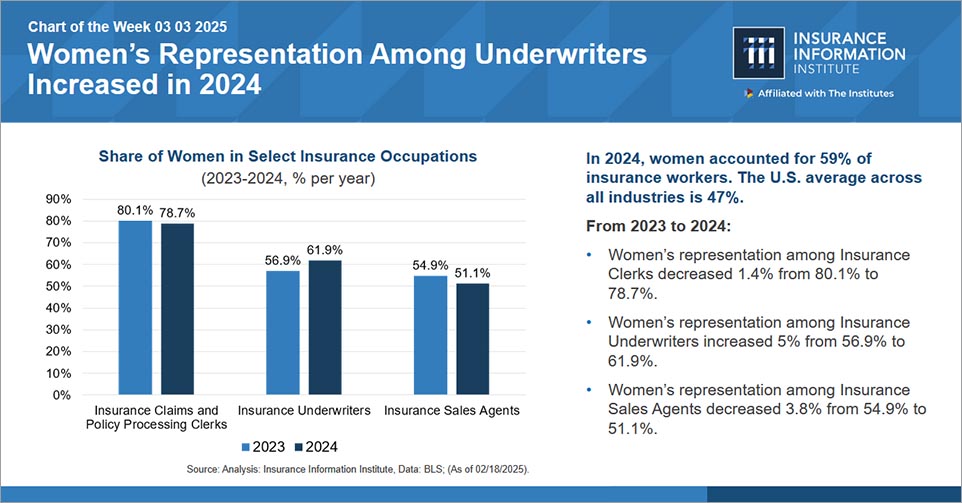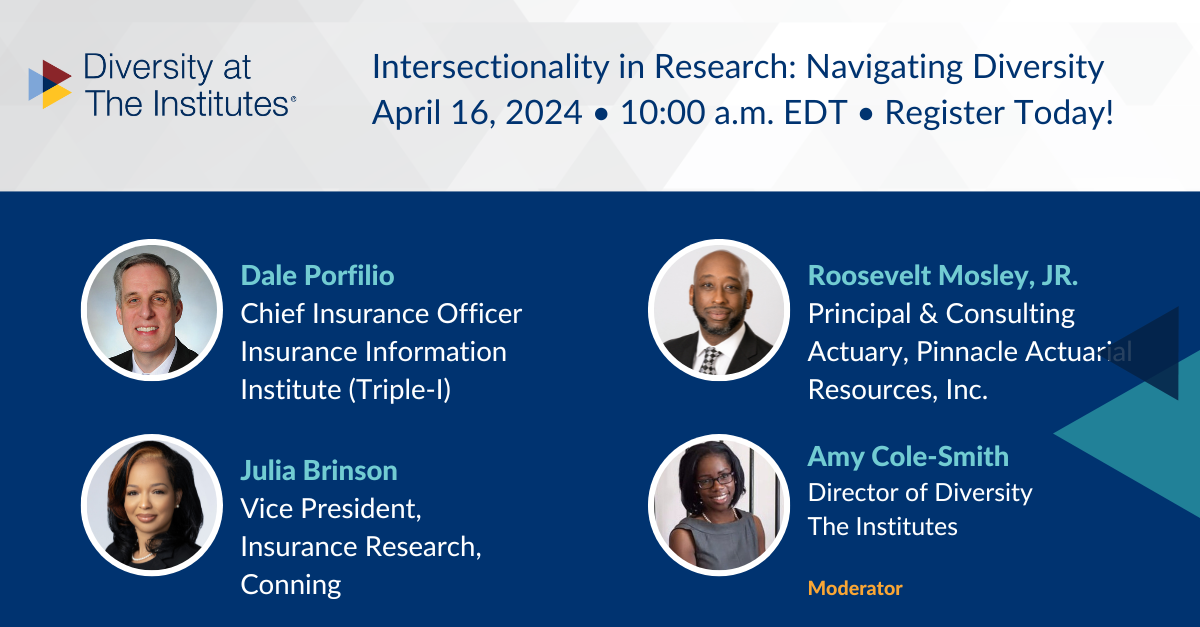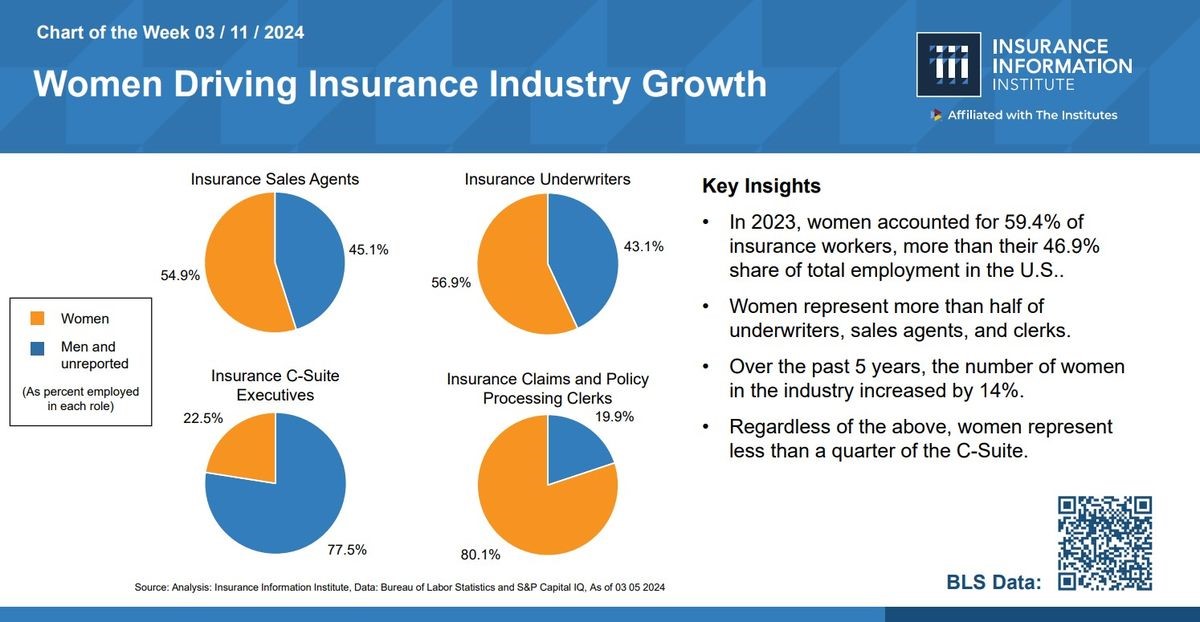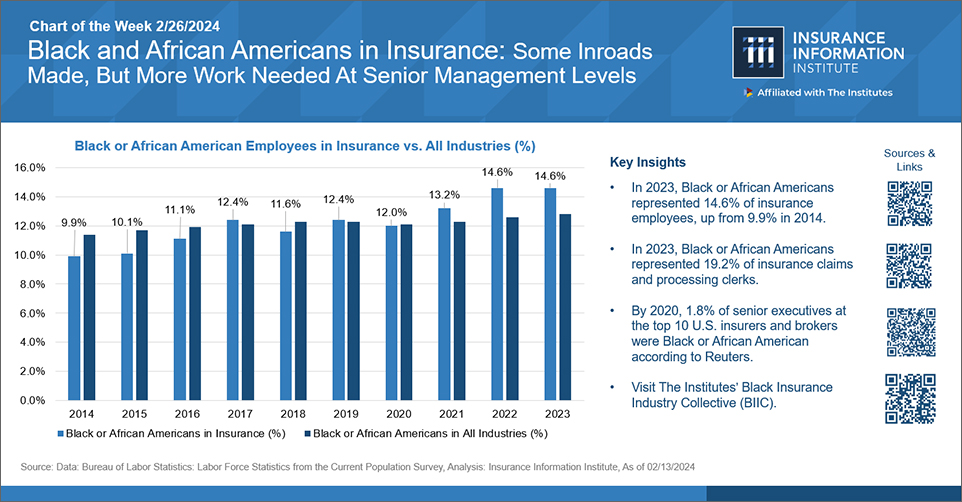
On March 3, Triple-I released its Chart of the Week, “Women’s Representation Among Underwriters Increased.” Citing data from the Bureau of Labor Statistics, the chart reveals that the number of women insurance Underwriters increased by 5 percent from 56.9 percent to 61.9 percent in 2024.
The insurance sector provided about 3.0 million jobs–or 1.9 percent of U.S. employment (workers 16 years and over) in 2024. Data from the Bureau of Labor Statistics indicates that 1.7 million workers were women. Since 2012, women have comprised about the same overall proportion (about 59 percent) of the industry workforce each year. However, the latest COTW shows that representation continues to vary across occupations. From 2023 to 2024, women’s representation among Insurance Clerks decreased 1.4 percent, from 80.1 percent to 78.7 percent. Representation among Insurance Sales Agents decreased 3.8 percent, from 54.9 percent to 51.1 percent.
The average representation of women across the U.S. workforce is 47 percent based on data from households in the Current Population Survey (CPS), an annual survey of business establishments in private industry conducted by the Bureau of Labor Statistics (BLS).
Life insurance, annuities, and home and auto insurance sectors are considerably more gender diverse than the average industry in North America, especially in entry-level jobs, where women make up two-thirds of the 70% of entry-level workers. In contrast to the abundance of representation at the bottom, the view across the top ranks looks notably different. Only about 22 percent (less than 1 in 4) of workers in the C-Suite are women, and only two women CEOs head up Fortune 500 insurance companies: Thasunda Brown Duckett, President and Chief Executive Officer of TIAA, and Tricia Griffith, President and Chief Executive Officer of the Progressive Group of Insurance Companies.
Nonetheless, women continue to demonstrate their skills, willingness to grow, and ability to influence the insurance industry in a positive and forward-thinking way. According to McKinsey, for every 100 men promoted to managerial positions, 104 women are promoted — much higher than the 87 women promoted across all industries. At the board level, women hold 40 percent of the seats in the aforementioned industry sectors.
However, from entry-level to managerial level, the women in the industry are predominantly white, with the leadership pipeline remaining even more closed off to women of color. Only one in 20 senior vice presidents and one in 35 direct reports to CEOs in insurance are women of color. Black women comprise more than 7 percent of the entry-level insurance workforce, but this number plummets along the corporate ladder and falls to virtually zero at the C-suite.
There’s evidence that women as workers in the insurance industry go back a long way, as far back as 1797. Their tremendous impact on the industry as consumers likely pivoted in 1839 with individual American states passing the Married Women’s Property Act, allowing life insurance proceeds to be passed to a widow without being subject to the demands of the husband’s debtors. By 1942, women accounted for 30% of total life insurance sales, and just two years later, women were buying 83% more life insurance than they did in 1942.
Today, keeping risk management solutions easily accessible and tailored to the market’s needs is arguably the biggest core challenge facing insurers. Research indicates that female CEOs among U.S. property-casualty insurance companies are associated with “lower insurer insolvency propensity, higher z-score, and lower standard deviation of return on assets.” Additionally, data suggested that as consumers, women tend to spend comparatively more of their income on insurance and have different consumer behavioral preferences that may compel a rethinking of insurance value chains.
Thus, insurers may discover that fostering an inclusive culture that welcomes more women into leadership can be a faster path to successful outcomes. Join us at the upcoming JIF 2025 event and follow our blog for more insights on the future of insurance.






